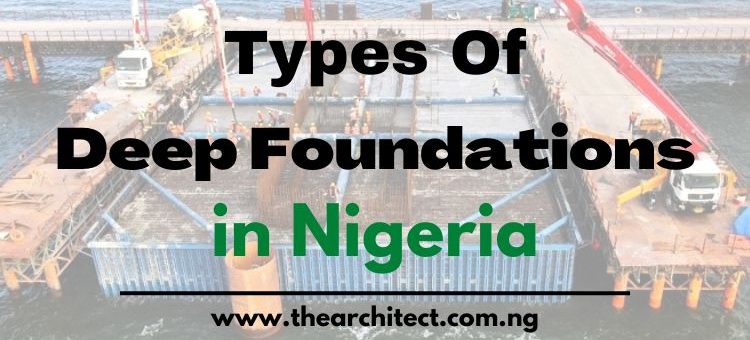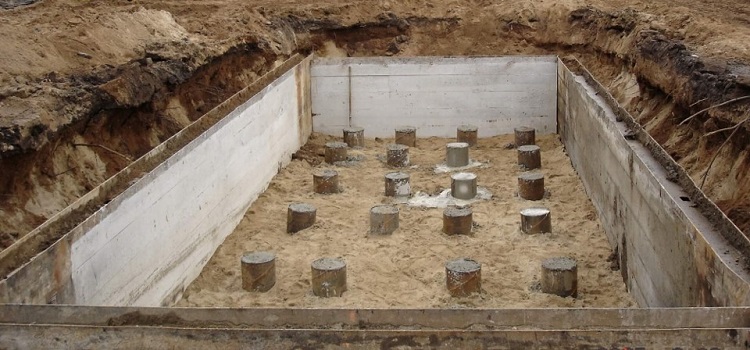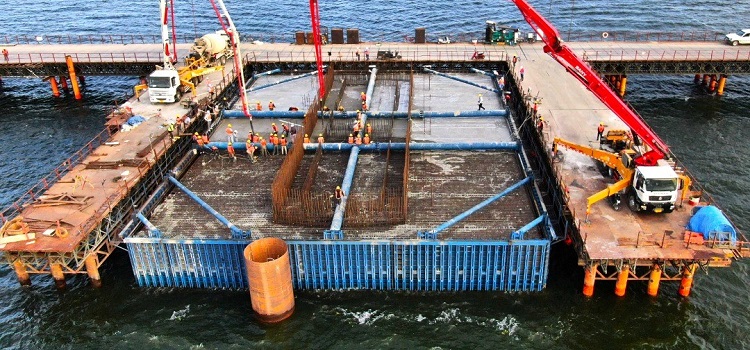
Types of Deep Foundation in Construction And Their Details
- Posted by Ikenna N.
- On July 11, 2025
- 0 Comments
There are several types of deep foundations in building construction. Deep foundations are those that are wider in width than they are deep. When the subsoil strata cannot safely support the loads caused by the construction, deep foundations are suggested. In this situation, the foundations’ founding level is lowered to a deeper location with the necessary bearing capability. TheArchitect has simplified the information below, kindly read further.
The loads placed on the structure are transmitted into the ground vertically. Several applications utilize deep foundations. They are regarded as the most reliable approach for transporting heavy loads over weaker soil strata. The following Deep foundation types are frequently used.
Table of Contents
Factors Affecting The Types of Deep Foundations in Construction
A deep foundation is a crucial element in construction projects, and several factors influence the choice of foundation.
Soil Type
The type of soil determines the type of foundation that is suitable for the project. For instance, if the soil is soft and unstable, a deep foundation such as a pile foundation is the best option. On the other hand, if the soil is stable and strong, a shallow foundation such as a spread footing is suitable.
Load Capacity
The load capacity of the foundation should match the load of the structure. For instance, if the structure is heavy, a deep foundation such as a drilled shaft is suitable because it can support a significant load. However, if the structure is light, a shallow foundation such as a mat foundation is appropriate.
Budget
The cost of the foundation is also a crucial factor in the choice of a deep foundation. Deep foundations are generally more expensive than shallow foundations. Therefore, the cost of the foundation should be considered in relation to the overall project budget. In some cases, a shallow foundation may be the best option if the project budget is limited.
It is essential to consider these factors carefully to ensure that the foundation is suitable for the project and meets the required standards.
Types of Deep Foundations in Construction
Pile Foundation

Source – CMQUEBRAL
Pile foundations are a type of deep foundation that is used to transfer heavy loads to deeper layers of soil. They are commonly used in construction projects that require support for tall structures or heavy machinery. Pile foundations consist of long, slender columns that are driven deep into the ground until they reach a layer of soil that is strong enough to support the load.
There are several types of pile foundations, including driven piles, cast-in-place piles, and helical piles. Driven piles are typically made of steel or concrete and are driven into the ground using a pile driver. Cast-in-place piles are formed by drilling a hole in the ground and then filling it with concrete. Helical piles are similar to driven piles, but they have helical blades that help to anchor them in the soil.
From a design perspective, foundations can be classified into the following pile types based on their load-bearing capacity or anchoring arrangement.
End Bearing Piles: End Bearing Piles are used when a pile only uses its ends to support the entire design load.
Friction Piles: Friction Piles are supported by the skin contact of the pile surface with the earth around it.
Anchored Piles: Compressive and tensile forces are transmitted to the ground by anchored piles.
Pile foundations are also categorized based on the material used. They could be
- Concrete Piles
- Steel Piles
- Wooden/Timber Piles
- Composite Piles
Pile foundations are a reliable and effective way to provide support for heavy loads. They are commonly used in construction projects such as bridges, high-rise buildings, and industrial facilities. By transferring the load to deeper layers of soil, pile foundations help to ensure the stability and safety of these structures.
Caissons Foundations

A caisson foundation is a water-retaining building that provides a workspace for pier foundation operations. Caisson foundations are a type of deep foundation used in construction. They are cylindrical structures that are drilled into the ground and filled with concrete or other materials. Caissons are commonly used in areas with soft soil or where the load from the building is too heavy for shallow foundations.
The construction process for caissons involves drilling a hole into the ground using a large drill bit. The hole is then filled with concrete or other materials to create a solid foundation. Caissons can be used for a variety of structures, including bridges, buildings, and offshore platforms.
One advantage of caissons is that they can be used in areas with limited space or difficult access. They are also able to support heavy loads and provide stability in areas with soft soil. However, the construction process for caissons can be expensive and time-consuming, as it requires specialized equipment and expertise. Overall, caissons are an important foundation option for many construction projects.
Drilled Shaft Foundation
A drilled shaft foundation is one of the types of deep foundations used in construction. It involves drilling a hole into the ground and filling it with concrete. This type of foundation is commonly used in areas with weak soil or where a large amount of weight needs to be supported.
The process of creating a drilled shaft foundation involves several steps. First, a hole is drilled into the ground using a drilling rig. The hole is then filled with concrete, which is reinforced with steel bars. The concrete is allowed to cure, creating a strong foundation that can support heavy loads.
Drilled shaft foundations have several advantages over other types of foundations. They can be used in a variety of soil conditions, including soft or unstable soil. They are also able to support heavy loads, making them ideal for large structures such as skyscrapers or bridges. Additionally, drilled shaft foundations are relatively easy to construct and maintain, making them a popular choice for many construction projects.
The drilled shaft foundation method has a similar construction technique to the caisson foundation. The difference is the caisson acts as a support for the concrete and may be removed at some point or maybe never.
Advantages of Deep Foundations
Deep foundations offer several advantages over shallow foundations.
- Firstly, they can support much heavier loads due to their depth and the fact that they transfer the load to a deeper and more stable layer of soil. This makes them ideal for large structures such as skyscrapers, bridges, and dams.
- Secondly, deep foundations are less affected by soil movements caused by changes in moisture content or temperature. This means that they are more resistant to settlement and can provide greater stability over time. Finally, deep foundations can be used in a wider range of soil conditions, including soft and loose soils, where shallow foundations would not be suitable.
- Another advantage of deep foundations is that they can be designed to withstand lateral loads, such as those caused by wind or earthquakes. This is achieved by using techniques such as pile caps, which distribute the load from the structure to the piles, and tiebacks, which anchor the foundation to the surrounding soil. By providing resistance to lateral loads, deep foundations can help to prevent structural damage and ensure the safety of occupants.
- In addition to their technical advantages, deep foundations can also be more cost-effective than shallow foundations in certain situations. While they may require more materials and labor to install, their ability to support heavier loads and provide greater stability can result in lower maintenance costs and a longer lifespan for the structure.
- Overall, the advantages of deep foundations make them a valuable option for engineers and builders when designing and constructing large and complex structures.
Disadvantages of Deep Foundations
Deep foundations are an essential part of construction projects that require support for heavy loads. However, they come with a few disadvantages that should be considered before opting for them.
- Firstly, deep foundations are expensive to construct. The process involves excavating a large hole, which requires heavy machinery and skilled labor. Additionally, the materials used for deep foundations, such as concrete and steel, are costly.
- Deep foundations can be time-consuming to construct. The process involves drilling deep into the ground, which can take several days or even weeks. This can cause delays in the construction schedule, which can be costly for the project owner.
- Lastly, deep foundations can be challenging to maintain. Due to their depth, repairs or maintenance work can be difficult and expensive. Additionally, any issues with the foundation can be hard to detect, which can lead to significant problems down the line.
While deep foundations are necessary for certain construction projects, they come with a few drawbacks that should be considered before choosing them. They are expensive, time-consuming, and challenging to maintain.
Conclusion
The various types of deep foundations previously explained are affected by several factors. Understanding these factors help determine the appropriate type to choose. Overall, a deep foundation is a valuable construction technique that has been used for many years to support structures in a wide range of environments. Whether you are building a skyscraper in a crowded urban area or a bridge over a deep river, a deep foundation is an excellent choice that will provide the support and stability that your structure needs to stand the test of time.





0 Comments